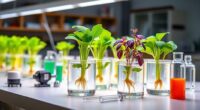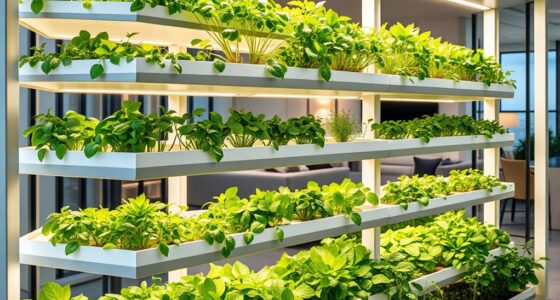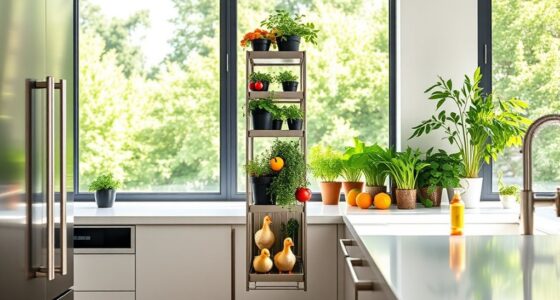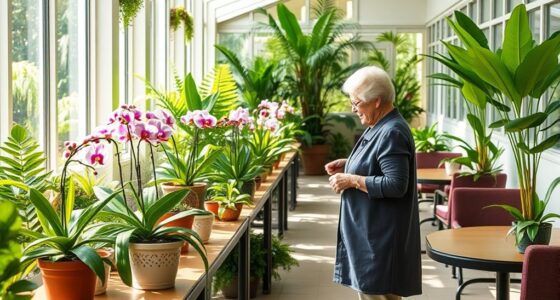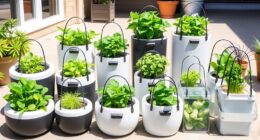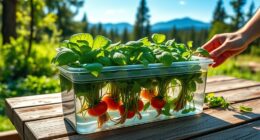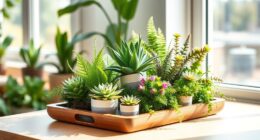To quickly set up your first indoor garden, start with the right lighting—use energy-efficient LED grow lights positioned 12-24 inches above your plants, ensuring 12-16 hours of daily light. Choose high-quality potting soil enriched with organic compost and make sure your pots have drainage holes. Water when the top inch of soil feels dry, avoiding overwatering. Pay close attention to your plants’ response, and if you keep at it, you’ll uncover even more tips for a thriving indoor green space.
Key Takeaways
- Choose a bright, south-facing window or supplement with LED grow lights for adequate sunlight.
- Use high-quality, well-draining potting soil enriched with compost or fertilizers.
- Position lights 12-24 inches above plants, on for 12-16 hours daily to mimic natural daylight.
- Water when the top inch of soil is dry, ensuring proper drainage to prevent root rot.
- Monitor plant response and adjust light, watering, and soil as needed for healthy growth.
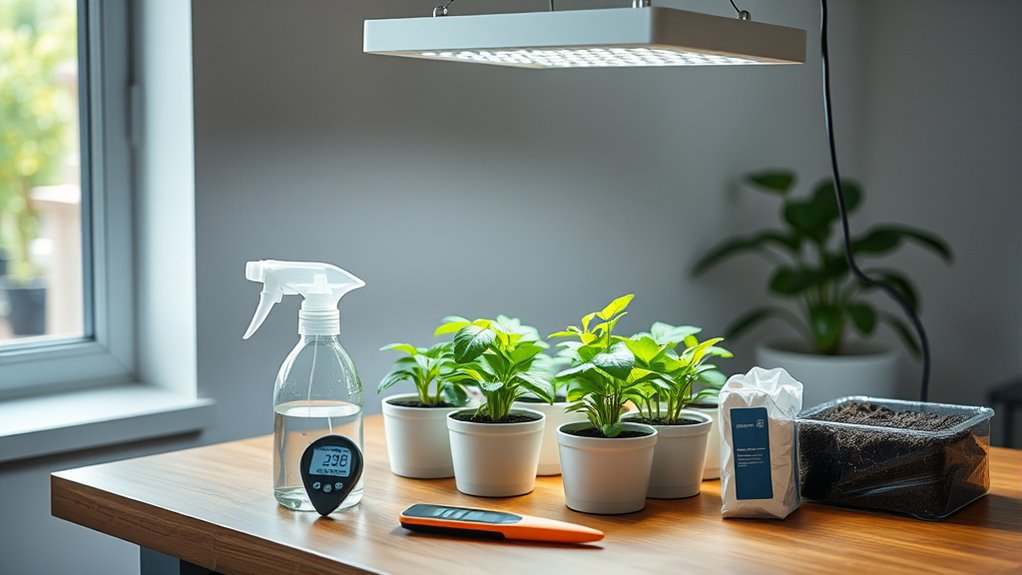
Setting up an indoor garden can be both rewarding and manageable if you plan carefully. The first step is understanding your lighting options, as proper light is essential for healthy plant growth. You’ll want to consider the amount of natural sunlight your space receives and then determine if supplemental lighting is necessary. If your windows face north or don’t get much direct sun, investing in grow lights is a smart move. LED grow lights are energy-efficient and customizable, allowing you to adjust the light spectrum to match your plants’ needs. Fluorescent lights are also affordable and effective for smaller setups. Position your lights about 12-24 inches above your plants, and ensure they’re on for around 12-16 hours daily, mimicking natural daylight cycles. This guarantees your plants receive enough energy to grow strong and healthy.
Next, soil preparation plays an essential role in setting up a thriving indoor garden. The right soil creates a foundation for your plants to develop roots, absorb nutrients, and flourish. Start by choosing a high-quality potting mix designed for indoor gardening—avoid garden soil, which can be too heavy and prone to pests or diseases indoors. You might want to add organic compost or slow-release fertilizers to enrich the soil. Before planting, loosen the soil to improve aeration, and check its drainage capability. Well-draining soil prevents water from pooling at the bottom of containers, which can lead to root rot. Make sure your pots have drainage holes, and consider adding a layer of gravel or small stones at the bottom to further promote water flow. When filling your pots, leave about an inch of space at the top to prevent soil from spilling when watering. Proper soil preparation sets the stage for healthy root development, making it easier for your plants to access nutrients and stay resilient against pests and diseases. Additionally, understanding the contrast ratio of your grow lights can help ensure your plants receive the optimal light quality for photosynthesis and growth.
As you move forward, remember that consistent care is key. Regularly check your lighting setup to guarantee it’s functioning correctly, and adjust your plants’ position if they seem to stretch toward the light. Keep an eye on moisture levels in the soil—watering when the top inch feels dry prevents over- or under-watering. With these foundational steps—selecting appropriate lighting options and preparing your soil—you’re well on your way to creating a thriving indoor garden. It may take some trial and error, but the satisfaction of nurturing your own green space makes every effort worthwhile. Stay attentive to your plants’ needs, and don’t hesitate to tweak your setup as you learn what works best for your environment. Soon enough, you’ll be enjoying fresh herbs, vibrant vegetables, or lush foliage right in your own home.
Frequently Asked Questions
How Do I Choose the Best Location for My Indoor Garden?
When choosing the best location for your indoor garden, focus on plant placement and space optimization. Pick a spot with ample natural light or where grow lights can be effective. Guarantee good air circulation and avoid drafts or temperature extremes. Think about accessibility for watering and maintenance. By carefully selecting your space, you’ll create a healthy environment that promotes growth and makes caring for your plants easier and more enjoyable.
What Are Common Pests and How Can I Prevent Them Indoors?
You’re likely to face common pests like aphids, spider mites, and fungus gnats. To prevent them, focus on pest identification early, inspect plants regularly, and maintain proper humidity and airflow. Use natural repellents such as neem oil or insecticidal soap to deter pests without chemicals. Keep your garden clean, remove infested leaves promptly, and quarantine new plants to stop pests from spreading, ensuring a healthy indoor garden.
How Often Should I Water Different Types of Indoor Plants?
You should adjust watering frequency based on your plant type and environment. For most indoor plants, water when the top inch of soil feels dry to the touch, ensuring proper plant hydration. Some plants, like succulents, need less frequent watering, while others, like ferns, require more regular attention. Always monitor your plants closely; overwatering can lead to root rot, so find the right balance to keep your indoor garden thriving.
What Lighting Options Are Most Energy-Efficient for Indoor Gardening?
Imagine your plants basking in gentle, bright LED lighting, their leaves shimmering with health. LED lighting is your best choice for energy savings, providing efficient, long-lasting light that mimics natural sunlight. It consumes less power, reducing your energy bills while supporting vibrant growth. By choosing LED options, you create an eco-friendly environment for your indoor garden, ensuring your plants thrive without draining your energy resources.
How Do I Troubleshoot Plant Diseases in an Indoor Environment?
When troubleshooting plant diseases indoors, start with plant disease identification by inspecting leaves, stems, and roots for spots, discoloration, or mold. Once identified, use organic treatment methods like neem oil or homemade compost teas to combat the issue. Guarantee proper airflow, avoid overwatering, and isolate affected plants to prevent spread. Regular monitoring and maintaining ideal humidity and light levels help keep your indoor garden healthy and disease-free.
Conclusion
By following these quick setup tips, you’re well on your way to a thriving indoor garden. Remember, patience and care are key—“Rome wasn’t built in a day,” and neither is a lush garden. Stay consistent, monitor your plants, and enjoy the process. Before you know it, you’ll be harvesting fresh herbs and veggies right from your own space. Keep at it, and your indoor garden will flourish beyond your expectations!

